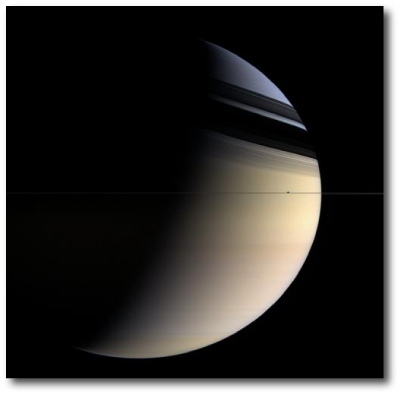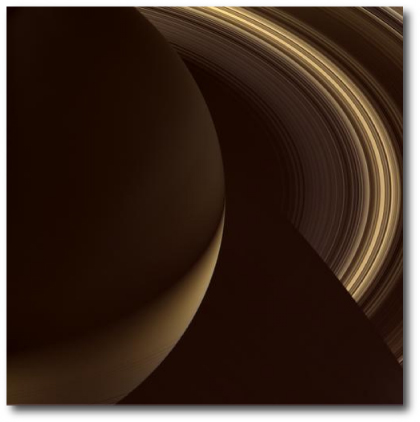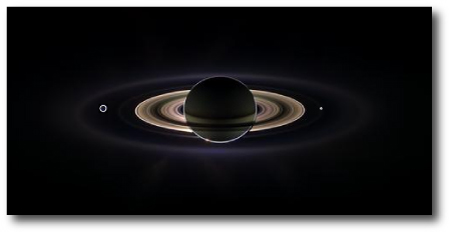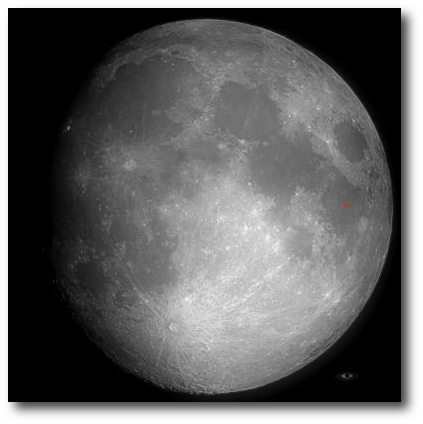
Image Source.
Newly published high-profile books get set out prominently on the display tables at the front of Borders in downtown Santa Cruz. During this past holiday season, one of the prime spots was given to Postcards from Mars by Cornell’s Jim Bell, who is the Pancam lead scientist for NASA’s Mars Exploration Rover Mission. The book is superbly produced. The Pancams’ high resolution allows the photos in the fold-out spreads to convey an impact that’s hard to achieve by surfing the NASA website with your browser.
With all the focus on Mars, I think the public tends to forget that Cassini, NASA’s flagship mission, is sending back an even more amazing trove of images from a far more alien environment. Indeed, Jeff Cuzzi (a colleague from my NASA Ames days) along with Laura Lovett and Joan Horvath, have just written a coffee-table book, Saturn A New View, that highlights the most stunning images of the Saturnian system. At the moment, the book is buried back in the science section at Borders, but it absolutely deserves a spot out in front as well. The “upgrade”, if you will, from Voyager to Cassini is an order of magnitude more impressive than the jump from Viking to Spirit and Opportunity.
I was nine years old when Viking 1 landed on Mars in 1976, and I vividly remember seeing the first images of the martian surface on the CBS morning news. I also recall that I was quite interested when the Voyagers sent back the first close-ups of Saturn and its environs, but I can’t remember the exact moment of seeing those photos for the first time. A quarter century later, this same gap in enthusiasm is reflected by the fact that the Mars book has an Amazon sales rank that is way ahead of the Saturn book.
On Mars, when you look at the landscape, the scene is familiar. It looks like a rocky desert on Earth. In the mind’s eye, you can place yourself on the surface. You can imagine hiking into the hills on the horizon. In short, you know what you’re seeing.

Image Source.
With Saturn, on the other hand, the views are abstract and alien. We don’t have rings in our sky, and so I’m intuitively unfamiliar with the play of shadows on the surface of the planet and the rings. When you look at views of Saturn, there’s no sense of being “right there”. You have to think more carefully to really see what you are seeing.

Image Source.
It amazes me that the size of Saturn and its rings is quite comparable to the Earth-Moon distance. Using Illustrator to superimpose the Earth and the Moon on the Saturnian system, the scale looks like this:

It took the Apollo astronauts about a day to traverse a distance equivalent to the diameter of Saturn. (It took them three days to make the trip from the Earth to the Moon.)
From Earth, when Saturn is visible overhead at midnight, it lies about 8.5 AU away. This means that the diameter of the A-ring subtends about 3/4 of an arc minute in the sky. That’s somewhat below the resolution limit of the human eye. If Saturn lay at Jupiter’s distance, however, people with sharp eyes would just barely be able to distinguish it as appearing slightly oblong.

Until I read the new Saturn book, I had not realized that the northern hemisphere of Saturn currently appears blue. It’s winter in Saturn’s northern hemisphere, and the tilt of the rings blocks additional sunlight from reaching the upper half of the planet. The frigid conditions have caused the ochre-colored haze to dissipate, and we have a view down to the methane-rich red-absorbing regions at greater depth. It’s the same effect that gives Neptune and Uranus their blue cast.
Billions of years from now, after the Sun has turned into a white dwarf, and after the planets have lost the majority of their internal heat, all four giant planets will take on the blueish color that Neptune and Uranus currently have. The current color of Saturn’s frigid northern hemisphere is an early preview of things to come.

OT: A link an AP story with some well deserved good press for the systemic project… http://news.yahoo.com/s/ap/20070114/ap_on_hi_te/virtual_astronomy_1
Keep up the good work.